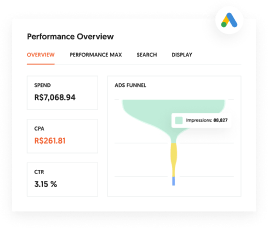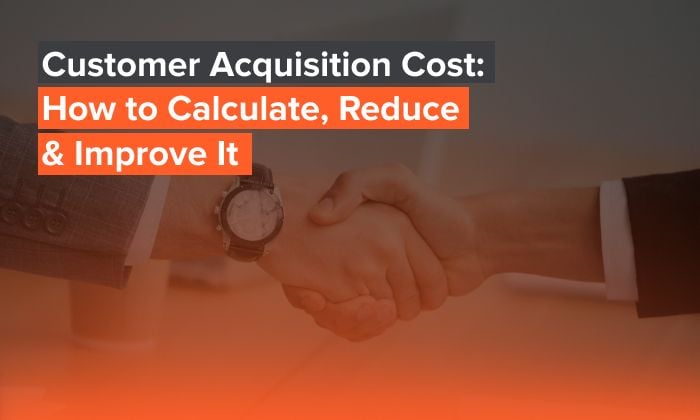
It’s a fact. You can’t grow a flourishing business if you’re not bringing in new customers, right? It’s something I’ve written about in-depth in my ultimate guide to customer acquisition. However, that’s only half the story. You also need to know how much each customer is costing you.
Customer acquisition cost (CAC) is a metric that has been growing with the emergence of Internet companies and trackable, web-based advertising campaigns.
Traditionally, a company had to engage in shotgun-style advertising and find methods to track consumers through decision-making.
Times have changed, though.
Today, many web-based companies can engage in highly targeted campaigns and track consumers as they progress from interested leads to long-lasting loyal customers. However, turning these prospects into loyal buyers isn’t free, and if you want your marketing efforts to be worthwhile, you need to know your customer acquisition cost.
In this article, I explain the CAC metric in more detail, how to measure it, and what steps you can take to improve it.
What Goes Into Customer Acquisition Costs?
There’s a lot to think about with your customer acquisition costs. Typically, advertising takes up the lion’s share of your budget, but there’s plenty more to consider, like:
- The cost of your marketing team and sales team
- Creative, technical, publishing, and production costs
- Inventory upkeep
On an ongoing basis, businesses also need to consider things like additional customer service resources or implementing new technologies to support new customers.
In addition, businesses should plan for the cost of lost customers over time due to churn.
What the CAC Metric Means to You and Your Business
The cost of customer acquisition matters now more than ever. Why? Because research shows that brands are losing around $29 for each new client.
In recent years, the cost of acquiring customers has increased by 60 percent, and companies are facing multiple challenges, such as the:
- increase in customer privacy legislation
- end of third-party cookies
- launch of iOS 14.5
As Jordan Jewell, former research director at IDC and now analyst in residence for VTEX, explains:
“Customer acquisition cost is a massive challenge for brands and retailers. Some brands now find it cheaper to acquire new customers by delivering personalized paper catalogs to their homes rather than acquire them via digital advertising.…”
The customer acquisition cost is also essential to potential investors.
Early-stage investors can determine a company’s profitability by looking at the difference between how much income your business makes from your buyers and the cost of securing them as customers.
Investors are more interested in providing the company with the resources it needs, partners are more committed to growth, and the company can use the improved profit margins to pass the value to its customers for a better market position.
How to Calculate Customer Acquisition Cost?
You can calculate the customer acquisition cost by simply dividing all the costs spent on acquiring more customers (marketing expenses) by the number of customers you acquire:
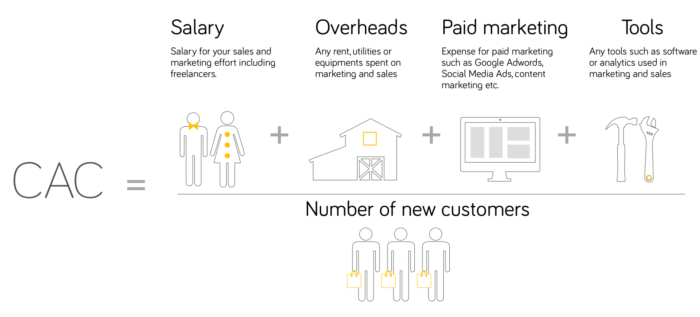
For example, if a company spends $100 on marketing annually and acquires 100 customers in the same year, its CAC is $1.00.
However, you should be aware of the caveats of using this metric.
For instance, a company may have invested in marketing in a new region or early-stage SEO that it does not expect to see results from until later. While rare, these instances may cloud the relationship when calculating the CAC.
It’s best you perform multiple variations to account for these situations. However, we will provide some examples of calculating the CAC metric in its most pragmatic and simple form with two examples. The first company (Example 1) has a poor metric. The second (Example 2) has a great one.
Example 1: An E-Commerce Company
In this example, we take a fictitious e-commerce company that sells organic food products. The company spent $100,000 on advertising last month, and its marketing team says someone placed 10,000 new orders. This suggests a CAC of $10, a figure that has no meaning.
If a Mercedes-Benz dealer has a CAC of $10, the management team will be delighted when looking at the year’s financial statements.
However, in the case of this company, the average order placed by customers is $25.00, and it has a markup of 100% on all products. This means that, on average, the company makes $12.50 per sale and generates $2.50 from each customer to pay for salaries, web hosting, office space, and other general expenses.
While this is a quick and dirty calculation, what happens if customers make more than one purchase over their lifetime? What if they stop shopping at brick-and-mortar grocery stores and buy from only this company?
Customer lifetime value (CLV) resolves this. You can find a CLV calculator by searching your favorite search engine. In general, this metric helps you better understand what the customer acquisition cost means to your company. Don’t worry, we’ll explain in greater detail what it will cover later.
A $10.00 customer acquisition cost may be relatively low if customers make a $25.00 purchase every week for 20 years! However, this e-commerce company struggles to keep customers; most customers make only one purchase.
Example 2: An Online CRM (SaaS) Software Company
In this example, we look at a company providing an online system for managing sales contacts for customer relationship management. The cost of distributing the software is low since it is cloud-based, and customers need little support.
It can also easily retain customers because of the pain customers would experience uploading all the contacts, tasks, and events they are tracking onto a new CRM software.
The company has worked its way up the search engines and has an expert sales support team working for minimum wage, based out of their call centers in a rural Midwestern town.
Additionally, the company has many strategic partnerships that provide a steady supply of customers. They spend only $2.00 acquiring a new customer with a lifetime value of $2,000. Here is the calculation:
- Total cost of new customer sales support call centers: $1,000,000/year
- Total price paid to strategic alliance partners per customer: $1.00
- Total monthly spending on search engine optimization: $20,000/year
Total new customers generated in the year: 1,020,000
Customer acquisition cost: ($1,020,000 / 1,020,000 customers) + $1.00 per customer = $2.00
As in our previous example, the amount is worth only the money extracted from customers. This company uses a customer retention calculation to determine its customer lifetime value (CLV) is $2,000.
This means this particular company can turn a $2.00 investment into $2,000 of revenue, which is attractive to investors and a signal to the marketing team that it’s an effective system.
What About CAC Per Marketing Channel?
Most marketers want to know the customer acquisition cost for each of their marketing channels.
If you know which channels have the lowest CAC, you know the best area to focus your marketing spend. The more you allocate your marketing budget to lower CAC channels, the more customers you can obtain for a fixed budget.
The simple approach is to grab your spreadsheet, gather all your marketing receipts for the year, quarter, or month, then add up those amounts by channel.
For example, how much did you spend on Google Ads and Facebook advertising? You might put this in a column called “PPC” or “pay-per-click.” How much did you spend on SEO and blogging? This might go into a column called “Inbound Marketing Costs.”
Now that you know how much you spent on each channel, you can apply a simplistic formula and assume each channel “worked” to get the same amount of customers as the next channel. This would be an averaging method.
The only issue is that knowing which channel is responsible for which customers can be challenging. You can easily see where this approach becomes futile.
Say you only ran one pay-per-click advertisement on one day – just as a test. You spent $10 total and that’s all. When you look at your spreadsheet, it would appear pay-per-click would be the best marketing channel because of its extremely low CAC. It would be unwise to double down on pay-per-click because you know you didn’t utilize it all for that period.
For e-commerce companies that sell physical products, it’s easy to know what pay-per-click advertisements lead to direct sales because of the conversion tracking the advertising platform provides.
In this case, you can determine that value and note this in your spreadsheet. This will give you a better idea of how your pay-per-click campaigns are relative to the rest of your marketing spend.
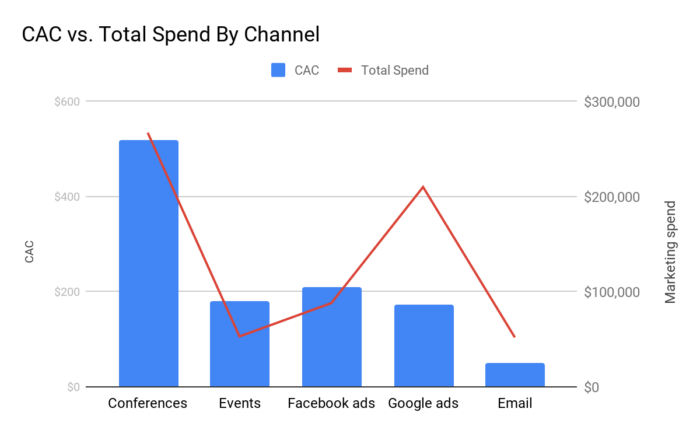
Also, with tools like customer analytics, you can trace paying customers back to their “last touch” attribution source. This means you can see the last channel the customer visited before doing their first sales with your online business.
As an example, if a customer came from an organic search result, you would know that your SEO efforts drove that particular acquisition.
How You Can Improve CAC
Your customer acquisition cost is often your most significant expense when attracting a new customer, and unfortunately, it’s tough to reduce.
However, that doesn’t mean you should stop testing new techniques or trying different marketing methods. Instead, you need to find other places to cut costs.
Sounds like a quandary, doesn’t it? Don’t worry, though, because I’ve got some tips that can help.
Explain the Product Well
A customer won’t purchase your product without understanding what it does. Your job is to make the features and benefits clear.
Look at this example from Nike:
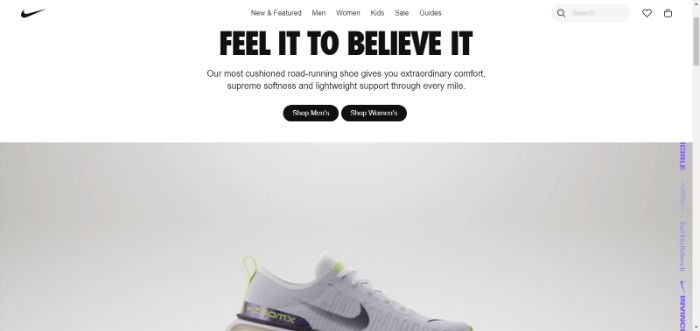
At a glance, you can see its running shoe:
- Offers extraordinary comfort
- Provides supreme softness and lightweight support
- Is cushioned for road running
The best thing about the page? It describes the features and benefits in two short sentences, along with a captivating image to emphasize the point.
See, this proves that sometimes, simple is best.
Answer All Questions
Potential customers might have questions outside the scope of a product introduction. That’s where your FAQ page comes in.
FAQ pages benefit the buyer and seller by answering common questions. As the seller, you don’t need to answer the same questions repeatedly, and prospects have the answers they want at a glance.
Here’s how the Dollar Shave Club does it:

It’s short and to the point, and answers the most pressing point. However, DSC offers a search function and a customer contact link for further info.
For more technical products, be sure to provide support documentation.
ConvertKit does a great job of breaking its help center articles into categories that make it easy for a confused customer to find the answer to their question quickly.
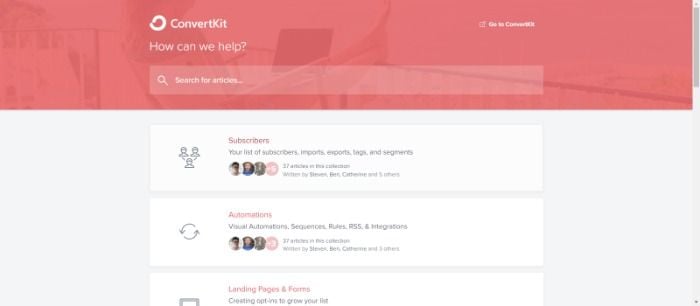
That’s the FAQs covered, now let’s discuss the importance of testimonials.
Include Testimonials
Don’t underestimate the power of testimonials. Whether a happy customer is leaving positive feedback on your social media, via email, or on your reviews page, ensure you feature some of the comments on your websites.
Showing comments from buyers who love your product or service can be an excellent way to eliminate common customer concerns.
Here’s an excellent example from Ahrefs:
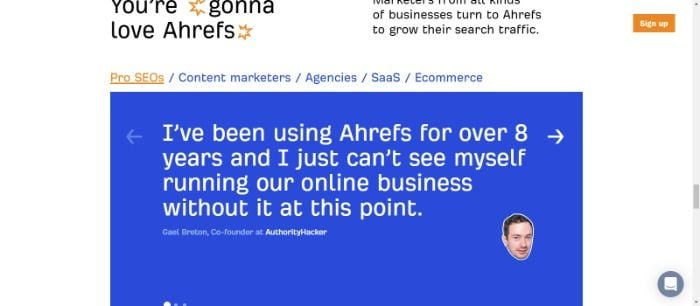
The company goes the extra mile by sharing testimonials from authority sources, along with a slideshow for greater engagement.
Finally, show consumers what product to buy with comparison charts.
Create Comparisons
Perhaps your lead is almost ready to buy, but they’re unsure which product is the best for them.
Creating comparison charts is one of the best ways to provide product information that potential customers can absorb at a glance.
If you want to see one of the best examples of this, just head over to Amazon. Here’s one for Nivea 48-hour body lotions:
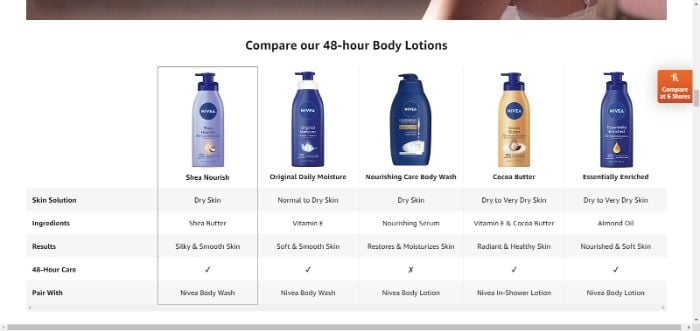
If you like the idea, Convertcart.com has great tips for creating effective charts for your products, including clearly showcasing social proof and creating an effective CTA.
Let’s just round this section off with a few more ways to improve your customer acquisition cost:
- Work on your website conversion optimization by looking at site speed, performance, and cart abandonment rates.
- Use a tool like Google Analytics to track your goals and perform A/B split testing to see what works best.
- Implement customer relationship management (CRM). Nearly all successful companies with repeat buyers implement some form of CRM.
Overall, if you can automate the process required to get a prospect to purchase, you’ll reduce the overall CAC. However, If your customer has a hefty LTV, you can work with an expensive CAC.
Customer Lifetime Value
Understanding your acquisition cost can take your business to the next level. However, looking at it in combination with your lifetime value is usually a good idea.
Customer lifetime value and customer acquisition cost (CAC) are essential in analyzing a company’s overall efficiency and profitability.
When used together, CLV and CAC provide valuable insights into the effectiveness of your business strategy. By understanding both metrics, you can assess whether your investment in acquiring customers is paying off.
Increasing Your Business Profits
Executive strategist and thought leader Jay Abraham once said there are three ways to increase your business’s profit.
You can:
- Get more buyers
- Enhance the value of each sale
- Encourage existing customers to buy more often.
Let’s look at these strategies closer.
Retention Rates
By working on your retention rates, you can increase the number of buyers without acquiring any new clients.
Just focusing on retention can completely change a company’s profit margin.
Research shows that increasing customer retention rates by 5% increases profits by 25-95%.
I have previously discussed some specific retention strategies. My article explained that your retention rates can soar by consistently making customers happy and learning what improvements they want. That’s all there is to it.
Increase Individual Sales Values
To enhance the lifetime value of each customer, go with a tried and tested method.
You probably know the phrase, ‘would you like fries with that.’ That’s an upsell in its most natural form. Fast food chains have used this approach for years and won’t stop using it anytime soon.
Aside from the upsell, you could use psychological principles to increase the value of each sale.
A couple of ways to do this is to add an even more premium product to your lineup. Alternatively, borrow yet another tactic from Amazon and offer a “frequently bought together” feature.
If you’ve ever shopped on Amazon, you’ll know the site recommends small additional, complementary purchases. Whatever you sell, you can almost certainly find another product that complements it.
Improve the Purchase Frequency
How can you do this? It’s simple!
Engaging with your customers by sending them useful content and tailoring promotional offers relevant to their interests is important.
By using data-driven marketing techniques like email campaigns and targeted offers to encourage repeat purchases from existing customers. Then you can:
- Customize messaging based on past buying behavior and send personalized offers that entice them into making additional purchases with your business.
- Send frequent email reminders with special offers or discounts tailored to buyers.
- Encourage repeat purchases by incentivizing customers through rewards programs or loyalty clubs.
- Offer a small discount when a buyer subscribes to a specific product.
You can also make sure that they know about new products or services that you offer, which could be an excellent incentive for them to come back and shop with you again.
Overall, smart marketing can allow you to maximize a buyer’s LTV and bring in maximum profits.
What is customer acquisition cost?
CAC is the cost of convincing a potential customer to buy a product or service. It includes everything you do to attract a new customer, like your advertising, the staff you employ, and your tools.
What costs are part of total customer acquisition cost?
CAC includes advertising, employee and contractor salaries, tools, inventory maintenance, and other sales and marketing tactics.
How do I calculate customer acquisition cost?
Take your total expenses spent on acquiring customers over a specific time and divide it by the number of customers you gained in that same time.
How do I improve customer acquisition cost?
First, work on offering user value and building better customer relationships; the happier your customer is, the more likely they will stay with you.
Additionally, you could introduce a loyalty program, use upsells, offer premium products, and small discounts for subscribers.
Conclusion
Measuring and tracking your customer acquisition costs is imperative for investors and your company.
Investors can use CAC to help them decide whether or not they think your company is profitable and that it will remain so moving forward.
Businesses can use their customer acquisition cost to decide how to allocate resources and funds, strategize marketing campaigns, and guide them in their hiring and salary process.
Whether you want to improve your CAC strategy or CAC, your customer acquisition cost is simple enough to calculate. Use the methods detailed here, or simplify things further with an online tool.
What techniques do you use to lower your customer acquisition costs?
About the Author: Chase Hughes has six years of experience working in the consulting sector and three years in the private equity sector for large multi-nationals and emerging startups. He is the founding partner of a service that writes business plans for debt and equity capital for startups.

See How My Agency Can Drive More Traffic to Your Website
- SEO - unlock more SEO traffic. See real results.
- Content Marketing - our team creates epic content that will get shared, get links, and attract traffic.
- Paid Media - effective paid strategies with clear ROI.
Are You Using Google Ads? Try Our FREE Ads Grader!
Stop wasting money and unlock the hidden potential of your advertising.
- Discover the power of intentional advertising.
- Reach your ideal target audience.
- Maximize ad spend efficiency.

